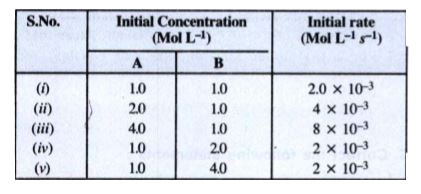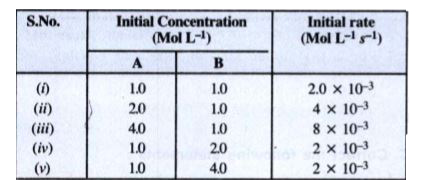For the reaction 2A+B→C, the values of initial rate at different reactant concentrations are given in the table below. The over all order of reaction is __________.

The correct Answer is:3
From given data
Rate =k[A]a[B]b
Now , 0.045=k[0.05]a+b ….(i)
0.090=k[0.05]a+b2a …(ii)
0.72=k[0.5]a+b.2(2a+b) ….(iii)
From equation (i) and (ii) we get ,
⇒12=12a⇒a=1
And from equation (i) and (iii) we get
⇒0.0450.72=122+b⇒45720=122+b
⇒720=22+b⇒24=22+b⇒b=2
Topper's Solved these Questions
Similar Questions
For the reaction 2A+B→C, the values of initial rate at different reactant concentrations are given in the table below. The rate law for the reaction is : [A](molL−1)[B](molL−1)Initial Ratemol−1s−10.050.050.0450.100.050.0900.200.100.72
View SolutionFor the reaction 2A+B→C, the values of ini concentrations are given in the table below. The rate law for the reaction is:

View SolutionFor the reaction A+B→C+D, the initial rate for different reactions and initial concentration of reactants are given below:

(i) What is the overall order of reaction ?
(ii) Write the rate law equation.
View SolutionConsider the reaction, A+B→C+D.
The initial rate for different initial concentrations of the reactants are given below :

What is the overall order ?
View SolutionConsider the reaction, A+B→C+D.
The initial rate for different initial concentrations of the reactants are given below :

What is the overall order ?
View SolutionConsider the reaction, A+B→C+D.
The initial rate for different initial concentrations of the reactants are given below :

What is the overall order ?
View SolutionConsider the reaction, A+B→C+D.
The initial rate for different initial concentrations of the reactants are given below :

Write the rate law equation.
View SolutionConsider the reaction, A+B→C+D.
The initial rate for different initial concentrations of the reactants are given below :

Write the rate law equation.
View SolutionConsider the reaction, A+B→C+D.
The initial rate for different initial concentrations of the reactants are given below :

Write the rate law equation.
View SolutionConsider the reaction, A+B→C+D.
The initial rate for different initial concentrations of the reactants are given below :

Calculate the rate constant.
View Solution
